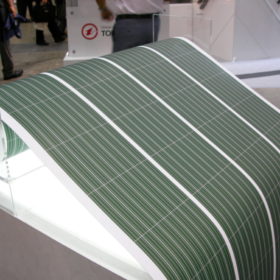
Researchers at the Indian Institute of Technology Kanpur have developed 12×12 cm2 sub-modules from organic solar PV cells on a paper substrate that could be used to power flexible electronic devices under an indoor lighting environment. The modules are said to deliver a power density of up to 12 µW/cm2 under illumination from a 1000-lux cool‐white LED.
Paper is an environmentally friendly alternative to plastic and other non-biodegradable substrates to fabricate flexible organic solar photovoltaic (OPV) cells and panels. OPV cells and modules built on paper substrates are bendable, proving their utility for flexible electronics while leaving less debris at end-of-life disposal.
Indian Institute of Technology Kanpur (IIT Kanpur) researchers have fabricated 12×12 cm2 sub-modules from OPV cells built on paper substrates with an active area of 108 cm2 that exhibit performance comparable to a silicon PV device under illumination from a 1000-lux cool‐white light-emitting diode (LED).
Under “standard illumination” (1 sun intensity and AM1.5G spectrum), the researchers demonstrated active-area power conversion efficiencies of up to 4.23% with PTB7:PCBM blend and 2.38% with P3HT:PCBM blend photoactive layers. They claim the results to be among the highest reported efficiencies for sub-modules of organic solar cells built on paper substrates to date.
“Due to better spectrum matching, the modules delivered a power density of up to 12 µW/cm2 under illumination from a 1000-lux cool‐white LED, which is comparable to 13 µW/cm2 from a silicon PV device (with a power conversion efficiency of 15% under standard illumination) for the same illumination. The results confirm the utility of these organic solar cells for indoor lighting environment,” electrical engineering professor S. Sundar Kumar Iyer from IIT Kanpur told pv magazine.
Researchers developed an effective barrier layer to successfully build organic solar cells on paper substrates prior to fabricating the sub-module.
“Small-area solar cells on paper substrates with efficiencies of 6.44 % with PTB7:PCBM blend and 3.37% with P3HT:PCBM blend photoactive layers were demonstrated. As of date, these are among the highest reported efficiency for organic solar cells built on paper substrates,” Iyer said.
According to the research team, choosing higher efficiency photoactive layers that are becoming available for organic solar cells should allow for building much higher efficiency sub-modules on paper substrates, which will be ideal for both indoor and outdoor applications.
The development work on OPV devices and sub-modules on paper substrates is being pursued by a team of researchers that includes Eswaran Jayaraman, Madhu Rawat and Sambathkumar Balasubramanian and coordinated by Professor Iyer at the National Centre for Flexible Electronics and the Samtel Centre for Display Technologies, IIT Kanpur. The research was supported by India’s Ministry of Electronics and Information Technology.
The findings are published in the journal Advanced Materials Technologies.
Lắp đặt điện mặt trời Khải Minh Tech
https://ift.tt/2X7bF6x
0906633505
info.khaiminhtech@gmail.com
80/39 Trần Quang Diệu, Phường 14, Quận 3
Lắp đặt điện mặt trời Khải Minh Tech
https://ift.tt/2ZH4TRU
Không có nhận xét nào:
Đăng nhận xét